Comparative economic systems • Market systems –

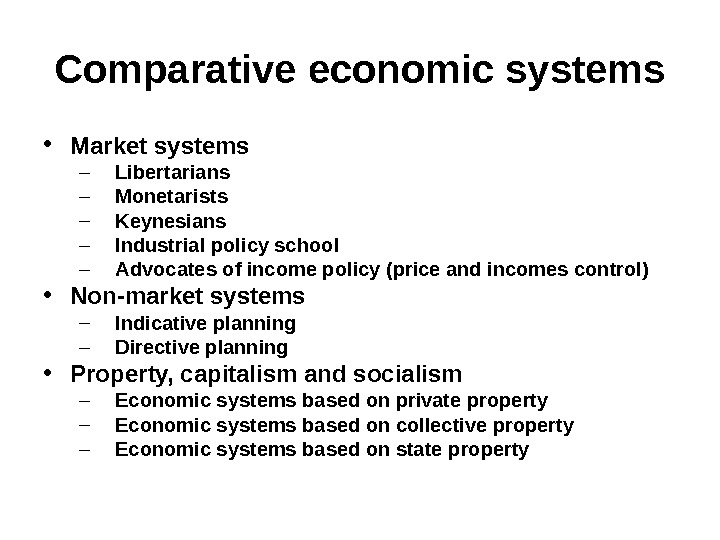




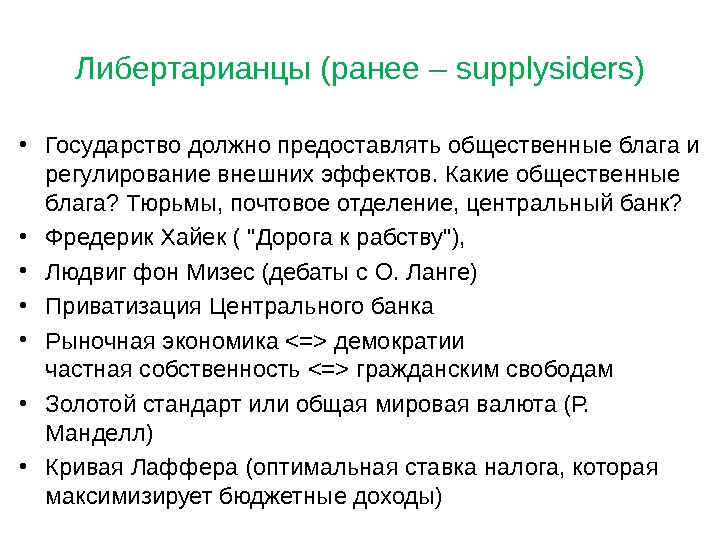

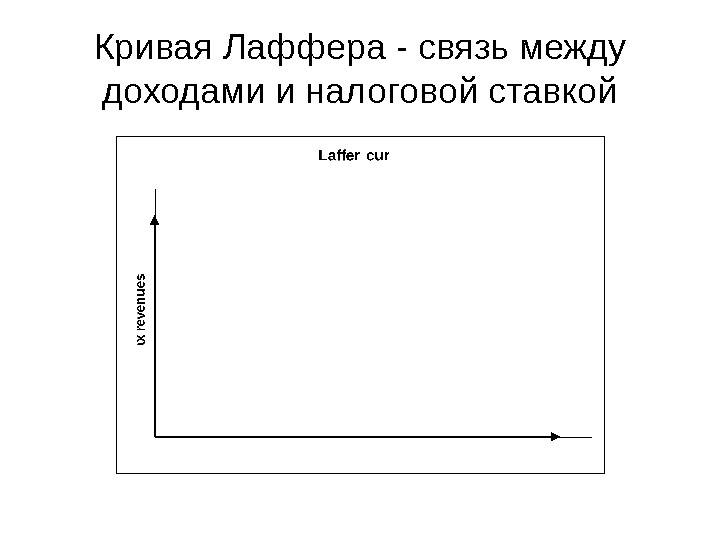
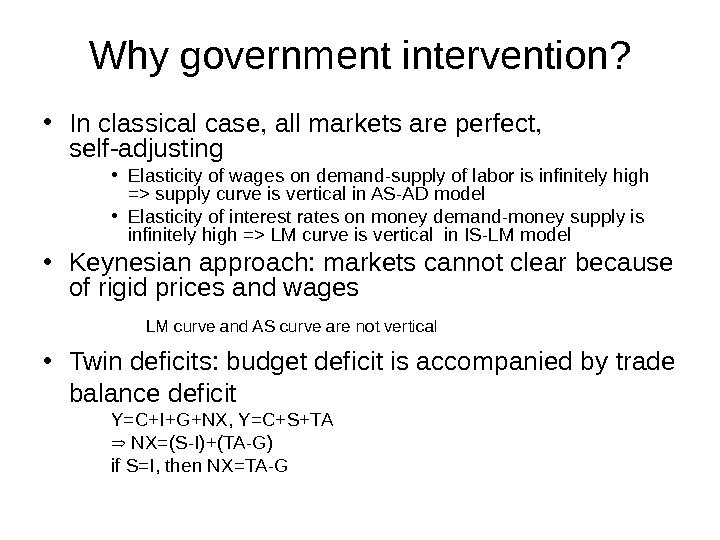
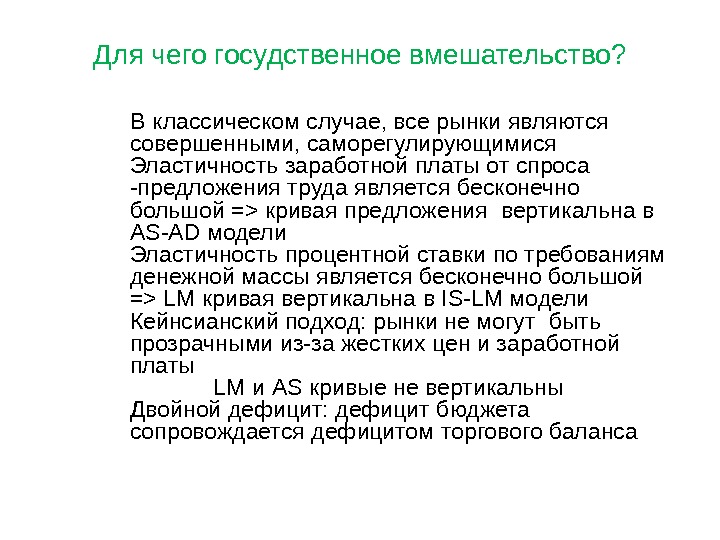


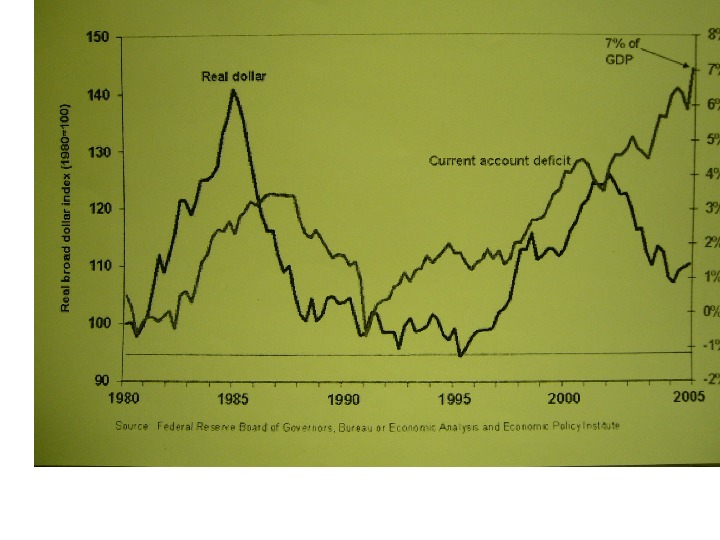

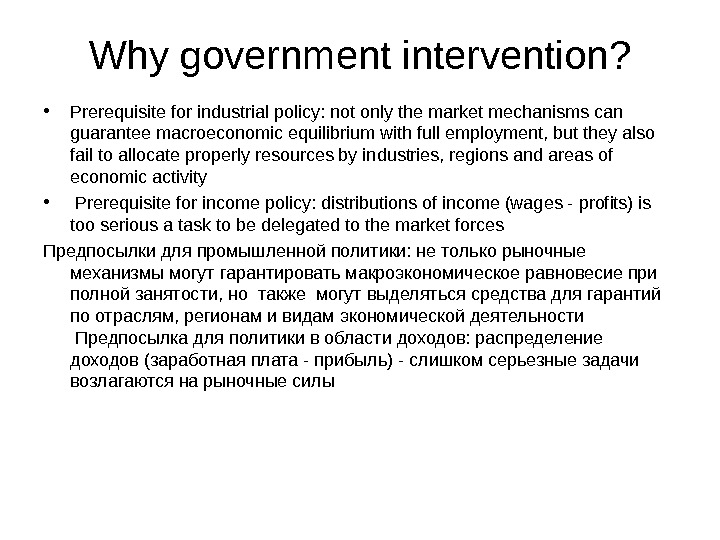

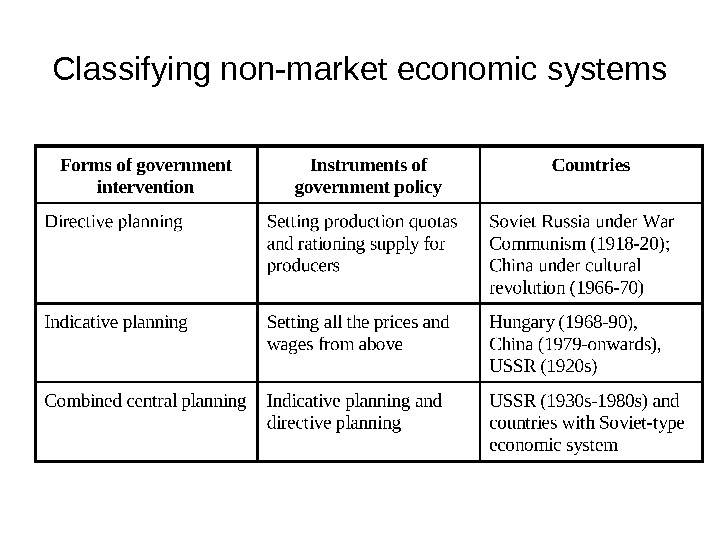


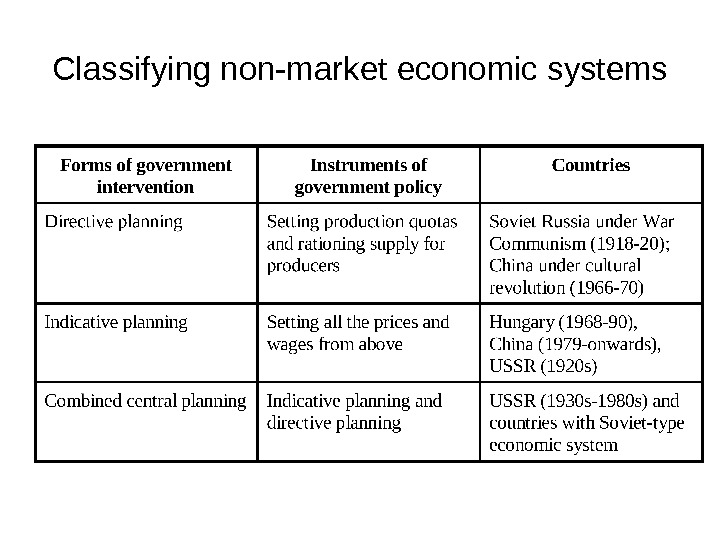
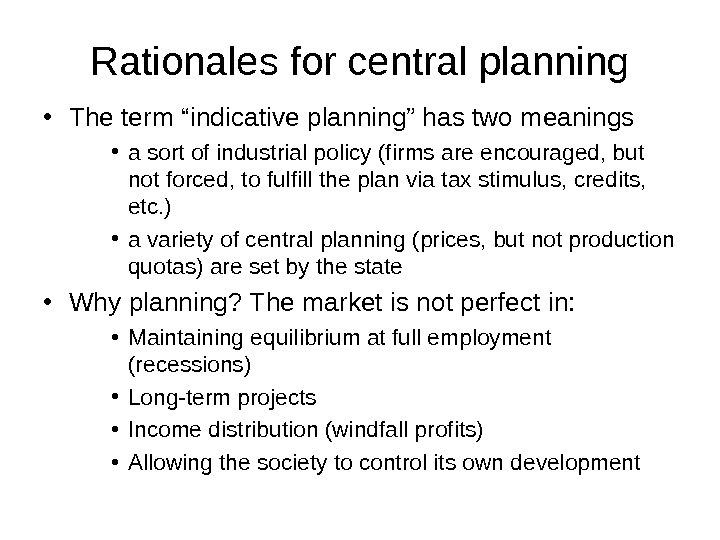

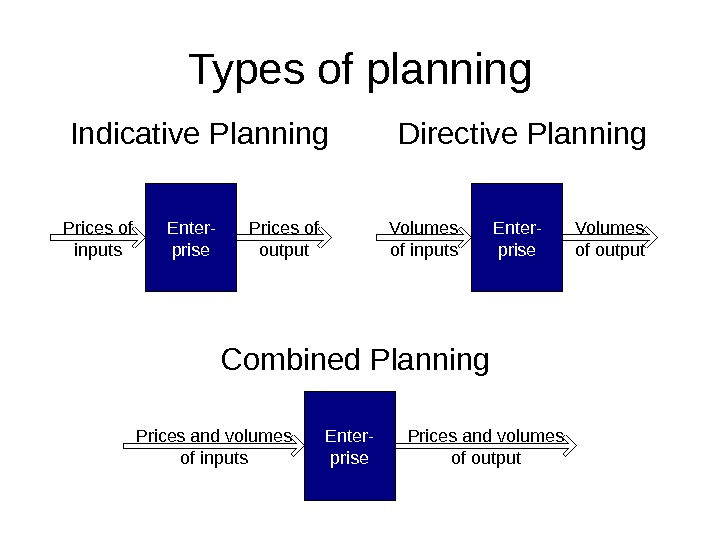
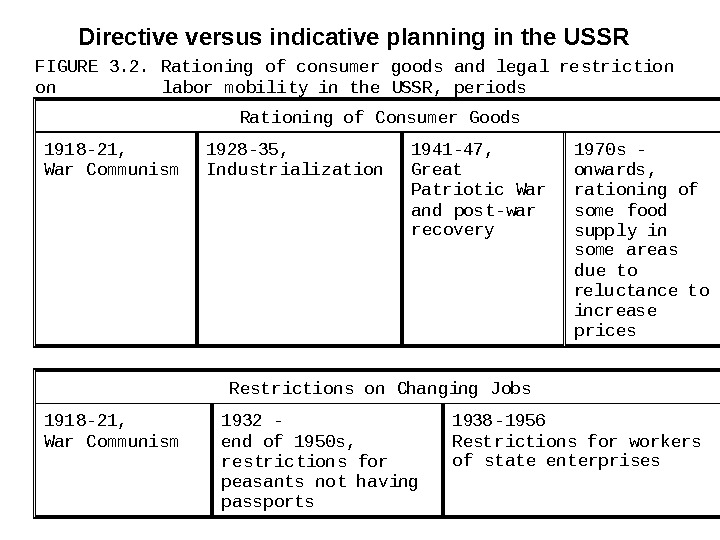
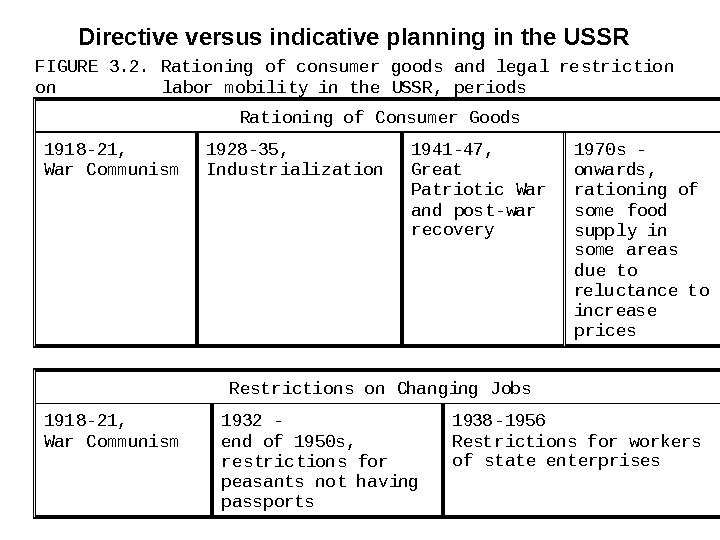
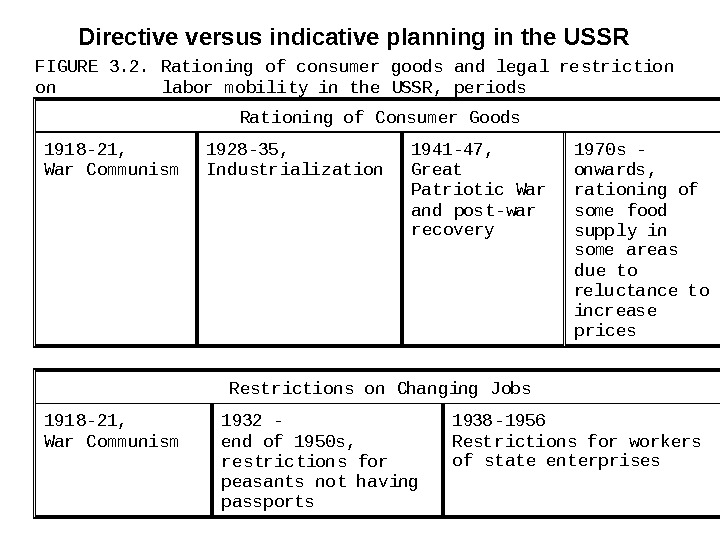
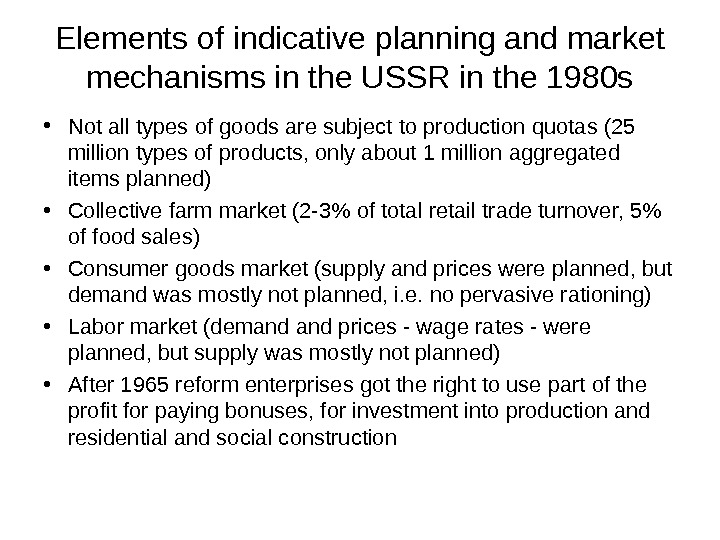
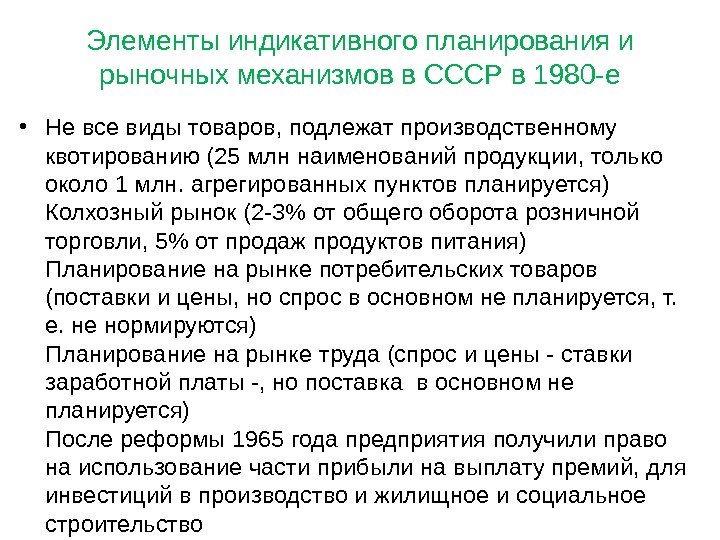


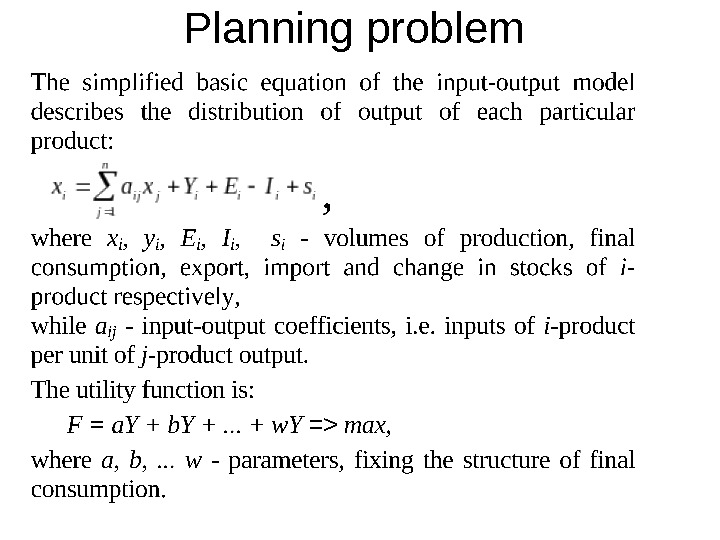



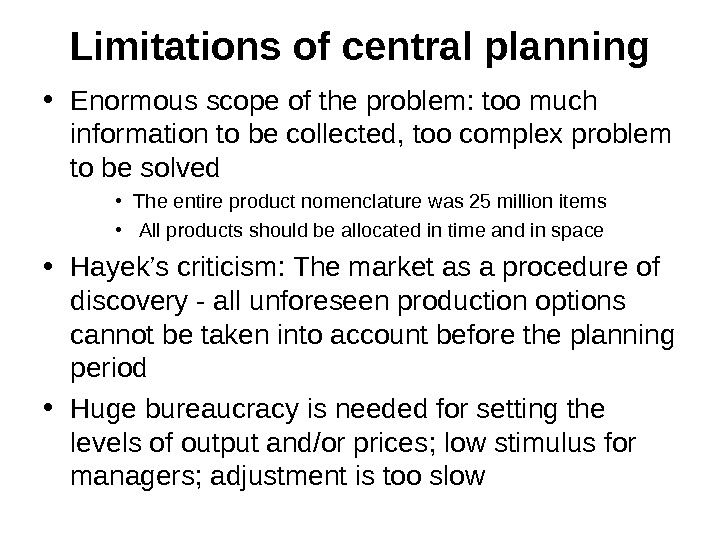
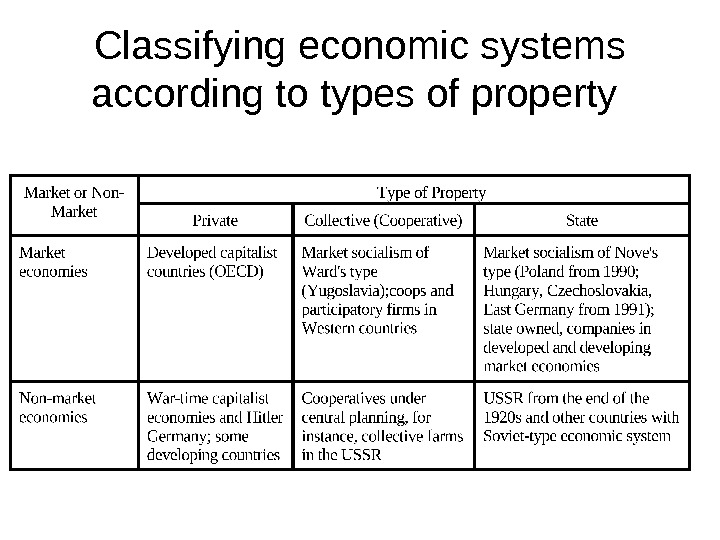
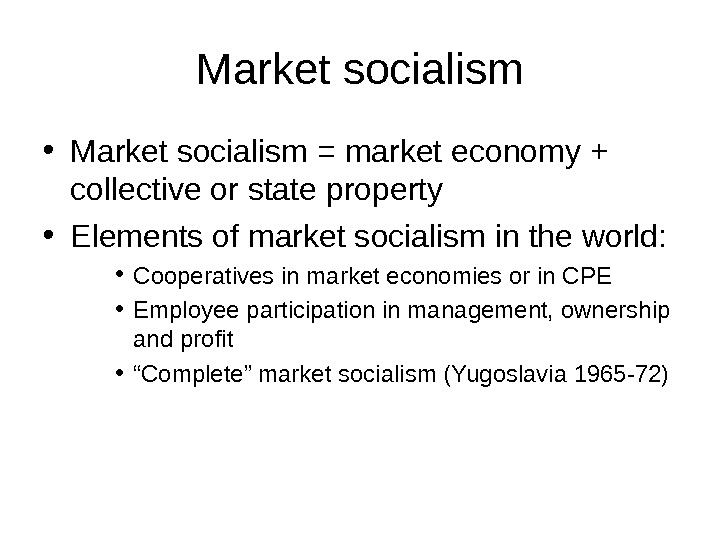
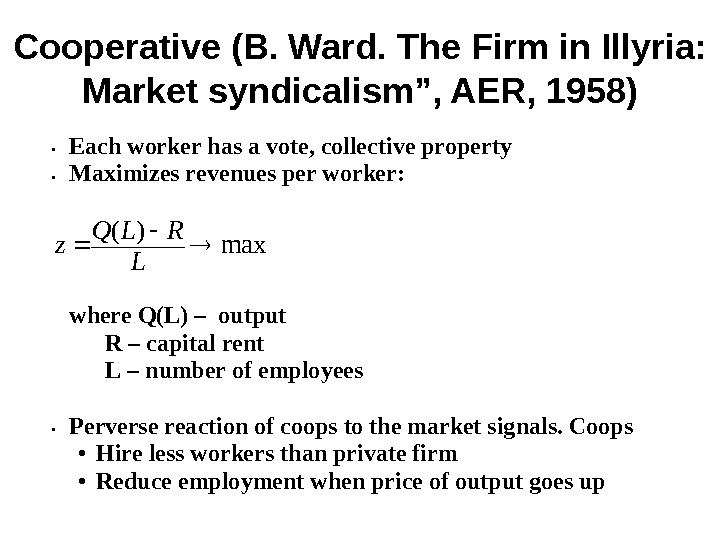
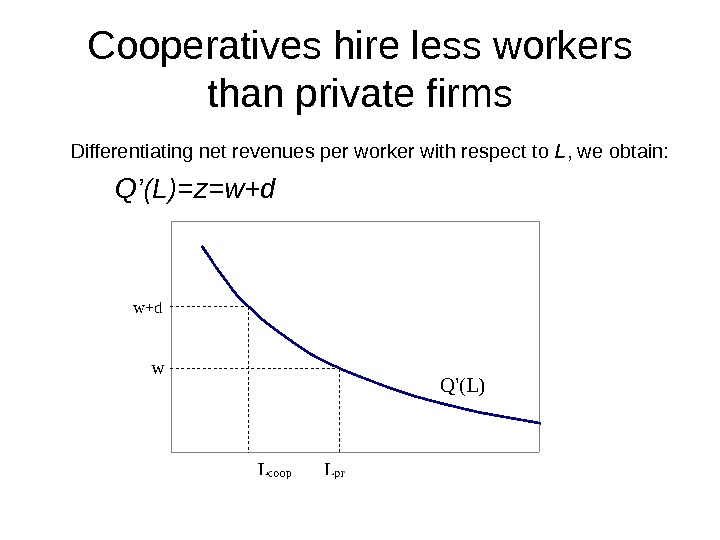

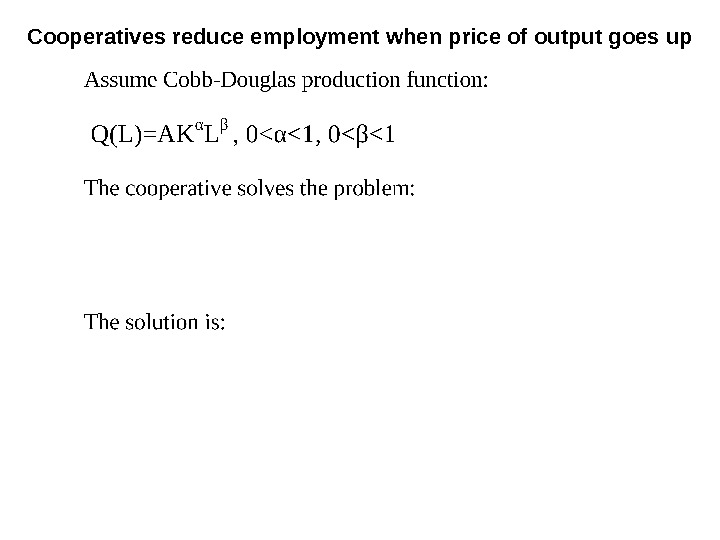
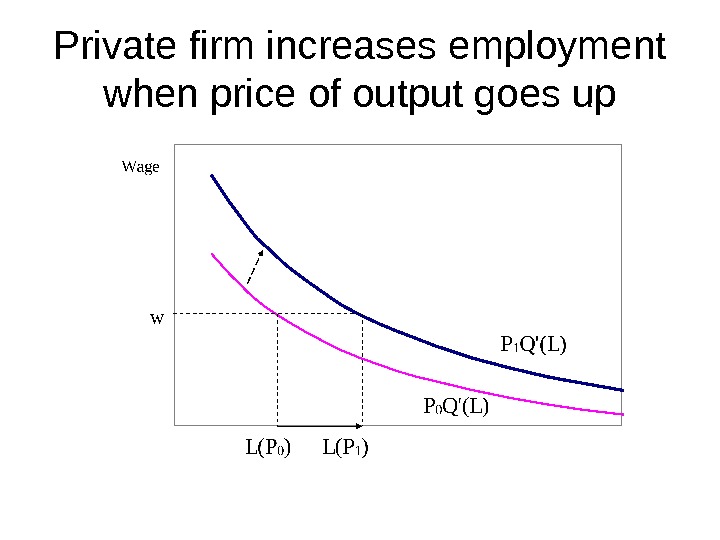

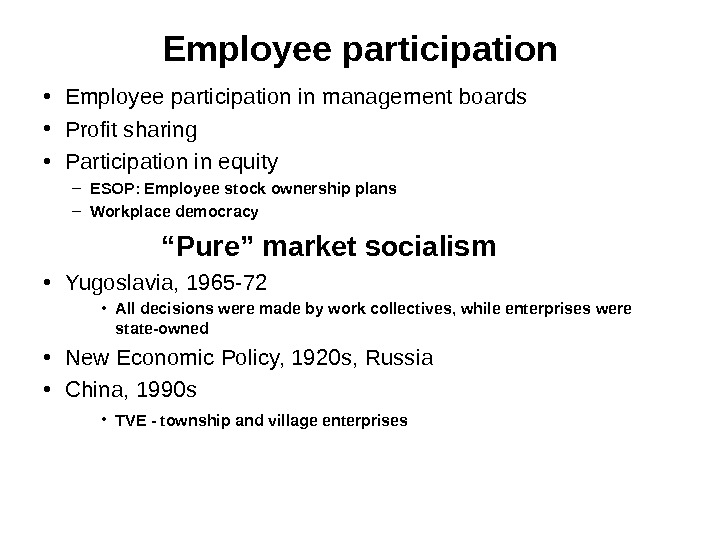
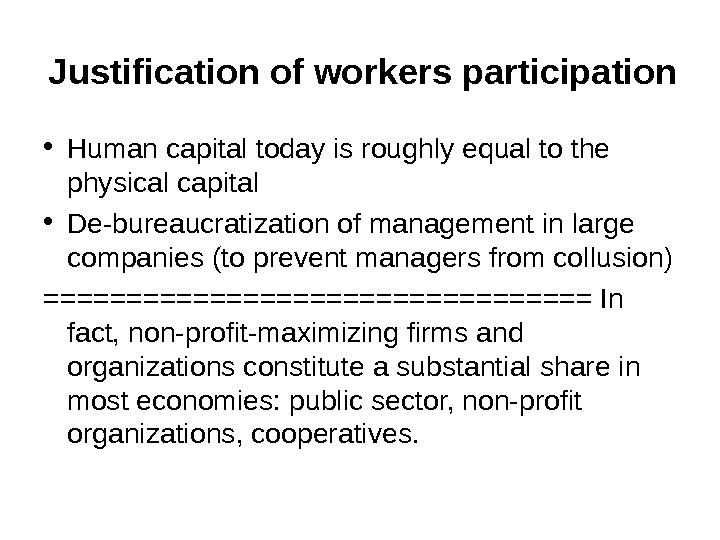
- Размер: 1.1 Mегабайта
- Количество слайдов: 45
Описание презентации Comparative economic systems • Market systems – по слайдам
 Comparative economic systems • Market systems – Libertarians – Monetarists – Keynesians – Industrial policy school – Advocates of income policy (price and incomes control) • Non-market systems – Indicative planning – Directive planning • Property, capitalism and socialism – Economic systems based on private property – Economic systems based on collective property – Economic systems based on state property
Comparative economic systems • Market systems – Libertarians – Monetarists – Keynesians – Industrial policy school – Advocates of income policy (price and incomes control) • Non-market systems – Indicative planning – Directive planning • Property, capitalism and socialism – Economic systems based on private property – Economic systems based on collective property – Economic systems based on state property
 Сравнительный анализ экономических систем • Рыночные системы — Либертарианцы — Монетаристы — Кейнсианцы -Школа промышленной политики -Сторонники политики доходов (контроля цен и доходов) • Нерыночные системы -Индикативное планирование -Директивное планирование • Собственность, капитализм и социализм -Экономические системы, основанные на частной собственности, -Экономические системы, основанные на коллективной собственности -Экономические системы, основанные на государственной собственности
Сравнительный анализ экономических систем • Рыночные системы — Либертарианцы — Монетаристы — Кейнсианцы -Школа промышленной политики -Сторонники политики доходов (контроля цен и доходов) • Нерыночные системы -Индикативное планирование -Директивное планирование • Собственность, капитализм и социализм -Экономические системы, основанные на частной собственности, -Экономические системы, основанные на коллективной собственности -Экономические системы, основанные на государственной собственности
 Classifying market economic systems according to the extent of government intervention
Classifying market economic systems according to the extent of government intervention
 Классификация рыночных экономических систем в зависимости от степени государственного вмешательства
Классификация рыночных экономических систем в зависимости от степени государственного вмешательства
 Libertarians (recently — supplysiders) • The state should provide public goods and regulate externalities. What are public goods? Prisons, post-office, central bank? • Frederick Hayek (“Road to slavery”), Ludwig von Mises (debates with O. Lange) • Privatization of the central bank • Market economy democracy private property civil liberties • Gold standard or common world currency (R. Mundell) • Laffer curve (optimal tax rate that maximizes budgetary revenues)
Libertarians (recently — supplysiders) • The state should provide public goods and regulate externalities. What are public goods? Prisons, post-office, central bank? • Frederick Hayek (“Road to slavery”), Ludwig von Mises (debates with O. Lange) • Privatization of the central bank • Market economy democracy private property civil liberties • Gold standard or common world currency (R. Mundell) • Laffer curve (optimal tax rate that maximizes budgetary revenues)
 Либертарианцы (ранее – supplysiders) • Государство должно предоставлять общественные блага и регулирование внешних эффектов. Какие общественные блага? Тюрьмы, почтовое отделение, центральный банк? • Фредерик Хайек ( «Дорога к рабству»), • Людвиг фон Мизес (дебаты с О. Ланге) • Приватизация Центрального банка • Рыночная экономика демократии частная собственность гражданским свободам • Золотой стандарт или общая мировая валюта (Р. Манделл) • Кривая Лаффера (оптимальная ставка налога, которая максимизирует бюджетные доходы)
Либертарианцы (ранее – supplysiders) • Государство должно предоставлять общественные блага и регулирование внешних эффектов. Какие общественные блага? Тюрьмы, почтовое отделение, центральный банк? • Фредерик Хайек ( «Дорога к рабству»), • Людвиг фон Мизес (дебаты с О. Ланге) • Приватизация Центрального банка • Рыночная экономика демократии частная собственность гражданским свободам • Золотой стандарт или общая мировая валюта (Р. Манделл) • Кривая Лаффера (оптимальная ставка налога, которая максимизирует бюджетные доходы)
 Laffer curve – the relationship between the revenues and tax rate
Laffer curve – the relationship between the revenues and tax rate
 Кривая Лаффера — связь между доходами и налоговой ставкой
Кривая Лаффера — связь между доходами и налоговой ставкой
 Why government intervention? • In classical case, all markets are perfect, self-adjusting • Elasticity of wages on demand-supply of labor is infinitely high => supply curve is vertical in AS-AD model • Elasticity of interest rates on money demand-money supply is infinitely high => LM curve is vertical in IS-LM model • Keynesian approach: markets cannot clear because of rigid prices and wages LM curve and AS curve are not vertical • Twin deficits: budget deficit is accompanied by trade balance deficit Y=C+I+G+NX, Y=C+S+TA NX=(S-I)+(TA-G) if S=I, then NX=TA-G
Why government intervention? • In classical case, all markets are perfect, self-adjusting • Elasticity of wages on demand-supply of labor is infinitely high => supply curve is vertical in AS-AD model • Elasticity of interest rates on money demand-money supply is infinitely high => LM curve is vertical in IS-LM model • Keynesian approach: markets cannot clear because of rigid prices and wages LM curve and AS curve are not vertical • Twin deficits: budget deficit is accompanied by trade balance deficit Y=C+I+G+NX, Y=C+S+TA NX=(S-I)+(TA-G) if S=I, then NX=TA-G
 Для чего госудственное вмешательство? В классическом случае, все рынки являются совершенными, саморегулирующимися Эластичность заработной платы от спроса -предложения труда является бесконечно большой => кривая предложения вертикальна в AS-AD модели Эластичность процентной ставки по требованиям денежной массы является бесконечно большой => LM кривая вертикальна в IS-LM модели Кейнсианский подход: рынки не могут быть прозрачными из-за жестких цен и заработной платы LM и AS кривые не вертикальны Двойной дефицит: дефицит бюджета сопровождается дефицитом торгового баланса
Для чего госудственное вмешательство? В классическом случае, все рынки являются совершенными, саморегулирующимися Эластичность заработной платы от спроса -предложения труда является бесконечно большой => кривая предложения вертикальна в AS-AD модели Эластичность процентной ставки по требованиям денежной массы является бесконечно большой => LM кривая вертикальна в IS-LM модели Кейнсианский подход: рынки не могут быть прозрачными из-за жестких цен и заработной платы LM и AS кривые не вертикальны Двойной дефицит: дефицит бюджета сопровождается дефицитом торгового баланса
 Для чего государственное вмешательство? • Каждая точка на кривой IS соответствует равновесию на товарном рынке, которое определяется соотношением национального дохода (Y) и процентной ставки (i). Кривая IS моделирует две зависимости: • Зависимость объёма инвестиций от процентной ставки. Чем выше процентная ставка, тем ниже инвестиции. Следственно падает национальное производство, и вместе с ним национальный доход. • Кейнсианский крест • В свою очередь, каждая точка на кривой LM соответствует равновесию на денежном рынке. Кривая LM моделирует зависимость процентной ставки от национального дохода. Чем выше доход, тем выше процентная ставка (высокий доход → более высокие расходы, связанные с потреблением → более высокий спрос на реальную кассу → более высокая процентная ставка). • Только в точке пересечения кривых достигается равновесие между обоими рынками. [1] • Интерпретация • Модель IS-LM позволяет визуализировать взаимосвязь таких макроэкономических величин как процентная ставка , денежная масса, уровень цен , спрос на реальную кассу, спрос на товары, производственный уровень экономики. Изменения одной или нескольких этих величин приводят к смещению точки пересечения кривых LM и IS, которая в свою очередь определяет уровень производства (и дохода) экономики, а так же соответствующий уровень процентной ставки.
Для чего государственное вмешательство? • Каждая точка на кривой IS соответствует равновесию на товарном рынке, которое определяется соотношением национального дохода (Y) и процентной ставки (i). Кривая IS моделирует две зависимости: • Зависимость объёма инвестиций от процентной ставки. Чем выше процентная ставка, тем ниже инвестиции. Следственно падает национальное производство, и вместе с ним национальный доход. • Кейнсианский крест • В свою очередь, каждая точка на кривой LM соответствует равновесию на денежном рынке. Кривая LM моделирует зависимость процентной ставки от национального дохода. Чем выше доход, тем выше процентная ставка (высокий доход → более высокие расходы, связанные с потреблением → более высокий спрос на реальную кассу → более высокая процентная ставка). • Только в точке пересечения кривых достигается равновесие между обоими рынками. [1] • Интерпретация • Модель IS-LM позволяет визуализировать взаимосвязь таких макроэкономических величин как процентная ставка , денежная масса, уровень цен , спрос на реальную кассу, спрос на товары, производственный уровень экономики. Изменения одной или нескольких этих величин приводят к смещению точки пересечения кривых LM и IS, которая в свою очередь определяет уровень производства (и дохода) экономики, а так же соответствующий уровень процентной ставки.
 Для чего государственное вмешательство? •
Для чего государственное вмешательство? •

 The US never had such a large current account deficit
The US never had such a large current account deficit
 Why government intervention? • Prerequisite for industrial policy: not only the market mechanisms can guarantee macroeconomic equilibrium with full employment, but they also fail to allocate properly resources by industries, regions and areas of economic activity • Prerequisite for income policy: distributions of income (wages — profits) is too serious a task to be delegated to the market forces Предпосылки для промышленной политики: не только рыночные механизмы могут гарантировать макроэкономическое равновесие при полной занятости, но также могут выделяться средства для гарантий по отраслям, регионам и видам экономической деятельности Предпосылка для политики в области доходов: распределение доходов (заработная плата — прибыль) — слишком серьезные задачи возлагаются на рыночные силы
Why government intervention? • Prerequisite for industrial policy: not only the market mechanisms can guarantee macroeconomic equilibrium with full employment, but they also fail to allocate properly resources by industries, regions and areas of economic activity • Prerequisite for income policy: distributions of income (wages — profits) is too serious a task to be delegated to the market forces Предпосылки для промышленной политики: не только рыночные механизмы могут гарантировать макроэкономическое равновесие при полной занятости, но также могут выделяться средства для гарантий по отраслям, регионам и видам экономической деятельности Предпосылка для политики в области доходов: распределение доходов (заработная плата — прибыль) — слишком серьезные задачи возлагаются на рыночные силы
 Why government intervention? • Предпосылки для промышленной политики: не только рыночные механизмы могут гарантировать макроэкономическое равновесие при полной занятости, но также могут выделяться средства для гарантий по отраслям, регионам и видам экономической деятельности • Предпосылка для политики в области доходов: распределение доходов (заработная плата — прибыль) — слишком серьезные задачи возлагаются на рыночные силы
Why government intervention? • Предпосылки для промышленной политики: не только рыночные механизмы могут гарантировать макроэкономическое равновесие при полной занятости, но также могут выделяться средства для гарантий по отраслям, регионам и видам экономической деятельности • Предпосылка для политики в области доходов: распределение доходов (заработная плата — прибыль) — слишком серьезные задачи возлагаются на рыночные силы
 Classifying non-market economic systems
Classifying non-market economic systems

 Classifying non-market economic systems
Classifying non-market economic systems
 Classifying non-market economic systems
Classifying non-market economic systems
 Rationales for central planning • The term “indicative planning” has two meanings • a sort of industrial policy (firms are encouraged, but not forced, to fulfill the plan via tax stimulus, credits, etc. ) • a variety of central planning (prices, but not production quotas) are set by the state • Why planning? The market is not perfect in: • Maintaining equilibrium at full employment (recessions) • Long-term projects • Income distribution (windfall profits) • Allowing the society to control its own development
Rationales for central planning • The term “indicative planning” has two meanings • a sort of industrial policy (firms are encouraged, but not forced, to fulfill the plan via tax stimulus, credits, etc. ) • a variety of central planning (prices, but not production quotas) are set by the state • Why planning? The market is not perfect in: • Maintaining equilibrium at full employment (recessions) • Long-term projects • Income distribution (windfall profits) • Allowing the society to control its own development
 Логическое обоснование для центрального планирования Термин «индикативное планирование» имеет два значения: • вариант промышленной политики (план рекомендуется фирмам, но не принудительно, — через налоговые стимулы, кредиты и т. д. ) • различные варианты централизованного планирования (цены, но не квоты на производство) устанавливаются государством Почему планирование? Рынок не является совершенным в: • Поддержание равновесия при полной занятости (спад) • Долгосрочные проекты • Распределение доходов (непредвиденные доходы) • Предоставлении обществу контролировать свое собственное развитие
Логическое обоснование для центрального планирования Термин «индикативное планирование» имеет два значения: • вариант промышленной политики (план рекомендуется фирмам, но не принудительно, — через налоговые стимулы, кредиты и т. д. ) • различные варианты централизованного планирования (цены, но не квоты на производство) устанавливаются государством Почему планирование? Рынок не является совершенным в: • Поддержание равновесия при полной занятости (спад) • Долгосрочные проекты • Распределение доходов (непредвиденные доходы) • Предоставлении обществу контролировать свое собственное развитие
 Types of planning Enter- prise. Indicative Planning Prices of inputs Prices of output Enter- prise. Volumes of inputs Volumes of output. Directive Planning Enter- prise. Prices and volumes of inputs Combined Planning Prices and volumes of output
Types of planning Enter- prise. Indicative Planning Prices of inputs Prices of output Enter- prise. Volumes of inputs Volumes of output. Directive Planning Enter- prise. Prices and volumes of inputs Combined Planning Prices and volumes of output
 Directive versus indicative planning in the USSR FIGURE 3. 2. Rationing of consumer goods and legal restriction on labor mobility in the USSR, periods Rationing of Consumer Goods 1918 -21, War Communism 1928 -35, Industrialization 1941 -47, Great Patriotic War and post-war recovery 1970 s — onwards, rationing of some food supply in some areas due to reluctance to increase prices Restrictions on Changing Jobs 1918 -21, War Communism 1932 — end of 1950 s, restrictions for peasants not having passports 1938 -1956 Restrictions for workers of state enterprises
Directive versus indicative planning in the USSR FIGURE 3. 2. Rationing of consumer goods and legal restriction on labor mobility in the USSR, periods Rationing of Consumer Goods 1918 -21, War Communism 1928 -35, Industrialization 1941 -47, Great Patriotic War and post-war recovery 1970 s — onwards, rationing of some food supply in some areas due to reluctance to increase prices Restrictions on Changing Jobs 1918 -21, War Communism 1932 — end of 1950 s, restrictions for peasants not having passports 1938 -1956 Restrictions for workers of state enterprises
 Directive versus indicative planning in the USSR FIGURE 3. 2. Rationing of consumer goods and legal restriction on labor mobility in the USSR, periods Rationing of Consumer Goods 1918 -21, War Communism 1928 -35, Industrialization 1941 -47, Great Patriotic War and post-war recovery 1970 s — onwards, rationing of some food supply in some areas due to reluctance to increase prices Restrictions on Changing Jobs 1918 -21, War Communism 1932 — end of 1950 s, restrictions for peasants not having passports 1938 -1956 Restrictions for workers of state enterprises
Directive versus indicative planning in the USSR FIGURE 3. 2. Rationing of consumer goods and legal restriction on labor mobility in the USSR, periods Rationing of Consumer Goods 1918 -21, War Communism 1928 -35, Industrialization 1941 -47, Great Patriotic War and post-war recovery 1970 s — onwards, rationing of some food supply in some areas due to reluctance to increase prices Restrictions on Changing Jobs 1918 -21, War Communism 1932 — end of 1950 s, restrictions for peasants not having passports 1938 -1956 Restrictions for workers of state enterprises
 Directive versus indicative planning in the USSR FIGURE 3. 2. Rationing of consumer goods and legal restriction on labor mobility in the USSR, periods Rationing of Consumer Goods 1918 -21, War Communism 1928 -35, Industrialization 1941 -47, Great Patriotic War and post-war recovery 1970 s — onwards, rationing of some food supply in some areas due to reluctance to increase prices Restrictions on Changing Jobs 1918 -21, War Communism 1932 — end of 1950 s, restrictions for peasants not having passports 1938 -1956 Restrictions for workers of state enterprises
Directive versus indicative planning in the USSR FIGURE 3. 2. Rationing of consumer goods and legal restriction on labor mobility in the USSR, periods Rationing of Consumer Goods 1918 -21, War Communism 1928 -35, Industrialization 1941 -47, Great Patriotic War and post-war recovery 1970 s — onwards, rationing of some food supply in some areas due to reluctance to increase prices Restrictions on Changing Jobs 1918 -21, War Communism 1932 — end of 1950 s, restrictions for peasants not having passports 1938 -1956 Restrictions for workers of state enterprises
 Elements of indicative planning and market mechanisms in the USSR in the 1980 s • Not all types of goods are subject to production quotas (25 million types of products, only about 1 million aggregated items planned) • Collective farm market (2 -3% of total retail trade turnover, 5% of food sales) • Consumer goods market (supply and prices were planned, but demand was mostly not planned, i. e. no pervasive rationing) • Labor market (demand prices — wage rates — were planned, but supply was mostly not planned) • After 1965 reform enterprises got the right to use part of the profit for paying bonuses, for investment into production and residential and social construction
Elements of indicative planning and market mechanisms in the USSR in the 1980 s • Not all types of goods are subject to production quotas (25 million types of products, only about 1 million aggregated items planned) • Collective farm market (2 -3% of total retail trade turnover, 5% of food sales) • Consumer goods market (supply and prices were planned, but demand was mostly not planned, i. e. no pervasive rationing) • Labor market (demand prices — wage rates — were planned, but supply was mostly not planned) • After 1965 reform enterprises got the right to use part of the profit for paying bonuses, for investment into production and residential and social construction
 Элементы индикативного планирования и рыночных механизмов в СССР в 1980 -е • Не все виды товаров, подлежат производственному квотированию (25 млн наименований продукции, только около 1 млн. агрегированных пунктов планируется) Колхозный рынок (2 -3% от общего оборота розничной торговли, 5% от продаж продуктов питания) Планирование на рынке потребительских товаров (поставки и цены, но спрос в основном не планируется, т. е. не нормируются) Планирование на рынке труда (спрос и цены — ставки заработной платы -, но поставка в основном не планируется) После реформы 1965 года предприятия получили право на использование части прибыли на выплату премий, для инвестиций в производство и жилищное и социальное строительство
Элементы индикативного планирования и рыночных механизмов в СССР в 1980 -е • Не все виды товаров, подлежат производственному квотированию (25 млн наименований продукции, только около 1 млн. агрегированных пунктов планируется) Колхозный рынок (2 -3% от общего оборота розничной торговли, 5% от продаж продуктов питания) Планирование на рынке потребительских товаров (поставки и цены, но спрос в основном не планируется, т. е. не нормируются) Планирование на рынке труда (спрос и цены — ставки заработной платы -, но поставка в основном не планируется) После реформы 1965 года предприятия получили право на использование части прибыли на выплату премий, для инвестиций в производство и жилищное и социальное строительство
 Theory of optimal planning • Given information: • Limitations on resources • Expenditure (inputs) of each and every type of resource needed for production of each product • Production targets for some final product • Structure of final consumption • Goal: to select the production levels for all resources and final products such that • Production of resources is equal to their intermediate consumption + final consumption • The final consumption (with the given structure) is maximized
Theory of optimal planning • Given information: • Limitations on resources • Expenditure (inputs) of each and every type of resource needed for production of each product • Production targets for some final product • Structure of final consumption • Goal: to select the production levels for all resources and final products such that • Production of resources is equal to their intermediate consumption + final consumption • The final consumption (with the given structure) is maximized
 Theory of optimal planning • Вводная информация: Ограничения на ресурсы Учёт расходов (затрат) каждого типа ресурсов, необходимых для производства каждого продукта Производственные задания для некоторого конечного продукта Структура конечного потребления • Цель: выбор уровня производства для всех ресурсов и готовой продукции Производство средств = их промежуточное потребление + конечное потребление Максимизируется конечное потребление (с заданной структурой )
Theory of optimal planning • Вводная информация: Ограничения на ресурсы Учёт расходов (затрат) каждого типа ресурсов, необходимых для производства каждого продукта Производственные задания для некоторого конечного продукта Структура конечного потребления • Цель: выбор уровня производства для всех ресурсов и готовой продукции Производство средств = их промежуточное потребление + конечное потребление Максимизируется конечное потребление (с заданной структурой )
 Planning problem
Planning problem
 Indicative planning: theoretical foundations • O. Lange — “trial and error method” • L. Kantorovich — “objectively determined valuations”, or “shadow prices”, from the dual problem of optimal planning • Particular set of prices calculated for each product in the main problem • If profit-maximizing producer is guided by these valuations as prices, he will inevitably arrive at the previously computed optimal plan from the main problem • Therefore, society can influence producers economically (via setting prices) – not administratively – so that they provide the maximum benefit for the entire society
Indicative planning: theoretical foundations • O. Lange — “trial and error method” • L. Kantorovich — “objectively determined valuations”, or “shadow prices”, from the dual problem of optimal planning • Particular set of prices calculated for each product in the main problem • If profit-maximizing producer is guided by these valuations as prices, he will inevitably arrive at the previously computed optimal plan from the main problem • Therefore, society can influence producers economically (via setting prices) – not administratively – so that they provide the maximum benefit for the entire society
 What is the difference between directive and indicative optimal plan? • In theory – results are the same • In practice – the results are inevitably different • Imagine new technology, that did not exist during the preparation of the plan, emerges during the planning period: – Under directive planning this new technology is not going to be used (no resources) – Under indicative planning, enterprises will have a chance to use this technology at the expense of taking resources away from other enterprises (so the balanced plan will be ruined) • Indicative planning is more flexible • It is impossible to envisage the emergence of all new technologies • Unforeseen options, such as new technologies, cannot materialize under directive planning
What is the difference between directive and indicative optimal plan? • In theory – results are the same • In practice – the results are inevitably different • Imagine new technology, that did not exist during the preparation of the plan, emerges during the planning period: – Under directive planning this new technology is not going to be used (no resources) – Under indicative planning, enterprises will have a chance to use this technology at the expense of taking resources away from other enterprises (so the balanced plan will be ruined) • Indicative planning is more flexible • It is impossible to envisage the emergence of all new technologies • Unforeseen options, such as new technologies, cannot materialize under directive planning
 Indicative planning vs. market • If “shadow prices” are adjusted taken into account supply/demand deviations (Lange’s trial and error” method), then indicative planning works as imitation of the market • Shadow prices (“objectively determined valuations”) reflect the priorities of socioeconomic development set by the planners — in the conditions of limited resources and information • Market prices reflect preferences of all economic agents
Indicative planning vs. market • If “shadow prices” are adjusted taken into account supply/demand deviations (Lange’s trial and error” method), then indicative planning works as imitation of the market • Shadow prices (“objectively determined valuations”) reflect the priorities of socioeconomic development set by the planners — in the conditions of limited resources and information • Market prices reflect preferences of all economic agents
 Limitations of central planning • Enormous scope of the problem: too much information to be collected, too complex problem to be solved • The entire product nomenclature was 25 million items • All products should be allocated in time and in space • Hayek’s criticism: The market as a procedure of discovery — all unforeseen production options cannot be taken into account before the planning period • Huge bureaucracy is needed for setting the levels of output and/or prices ; low stimulus for managers; adjustment is too slow
Limitations of central planning • Enormous scope of the problem: too much information to be collected, too complex problem to be solved • The entire product nomenclature was 25 million items • All products should be allocated in time and in space • Hayek’s criticism: The market as a procedure of discovery — all unforeseen production options cannot be taken into account before the planning period • Huge bureaucracy is needed for setting the levels of output and/or prices ; low stimulus for managers; adjustment is too slow
 Classifying economic systems according to types of property
Classifying economic systems according to types of property
 Market socialism • Market socialism = market economy + collective or state property • Elements of market socialism in the world: • Cooperatives in market economies or in CPE • Employee participation in management, ownership and profit • “ Complete” market socialism (Yugoslavia 1965 -72)
Market socialism • Market socialism = market economy + collective or state property • Elements of market socialism in the world: • Cooperatives in market economies or in CPE • Employee participation in management, ownership and profit • “ Complete” market socialism (Yugoslavia 1965 -72)
 Cooperative (B. Ward. The Firm in Illyria: Market syndicalism”, AER, 1958) • Each worker has a vote, collective property • Maximizes revenues per worker: ( ) max Q L R z L where Q(L) – output R – capital rent L – number of employees • Perverse reaction of coops to the market signals. Coops • Hire less workers than private firm • Reduce employment when price of output goes up
Cooperative (B. Ward. The Firm in Illyria: Market syndicalism”, AER, 1958) • Each worker has a vote, collective property • Maximizes revenues per worker: ( ) max Q L R z L where Q(L) – output R – capital rent L – number of employees • Perverse reaction of coops to the market signals. Coops • Hire less workers than private firm • Reduce employment when price of output goes up
 Cooperatives hire less workers than private firms Differentiating net revenues per worker with respect to L , we obtain: Q’(L)=z=w+d
Cooperatives hire less workers than private firms Differentiating net revenues per worker with respect to L , we obtain: Q’(L)=z=w+d
 Private firm and the increase in prices of output. Private firm solves the problem: L w. LLPAKmax The first order condition is: w. LPAKLPQ 1)(‘ Private firm increases employment and output, when prices increase
Private firm and the increase in prices of output. Private firm solves the problem: L w. LLPAKmax The first order condition is: w. LPAKLPQ 1)(‘ Private firm increases employment and output, when prices increase
 Cooperatives reduce employment when price of output goes up
Cooperatives reduce employment when price of output goes up
 Private firm increases employment when price of output goes up
Private firm increases employment when price of output goes up
 Cooperatives compared to the private firms • Advantages of cooperatives: • Higher labor productivity • Less sick leaves • Less strikes • Lower employee turnover • Lower managerial expenses • Higher work satisfaction • Disadvantages of cooperatives: • Capital scarcity (as the owner of capital is not remunerated fully; cooperative may not attract capital via selling shares) • Use of less capital-intensive technologies • Higher debts to assets ratio
Cooperatives compared to the private firms • Advantages of cooperatives: • Higher labor productivity • Less sick leaves • Less strikes • Lower employee turnover • Lower managerial expenses • Higher work satisfaction • Disadvantages of cooperatives: • Capital scarcity (as the owner of capital is not remunerated fully; cooperative may not attract capital via selling shares) • Use of less capital-intensive technologies • Higher debts to assets ratio
 Employee participation • Employee participation in management boards • Profit sharing • Participation in equity – ESOP: Employee stock ownership plans – Workplace democracy “ Pure” market socialism • Yugoslavia, 1965 -72 • All decisions were made by work collectives, while enterprises were state-owned • New Economic Policy, 1920 s, Russia • China, 1990 s • TVE — township and village enterprises
Employee participation • Employee participation in management boards • Profit sharing • Participation in equity – ESOP: Employee stock ownership plans – Workplace democracy “ Pure” market socialism • Yugoslavia, 1965 -72 • All decisions were made by work collectives, while enterprises were state-owned • New Economic Policy, 1920 s, Russia • China, 1990 s • TVE — township and village enterprises
 Justification of workers participation • Human capital today is roughly equal to the physical capital • De-bureaucratization of management in large companies (to prevent managers from collusion) ================= In fact, non-profit-maximizing firms and organizations constitute a substantial share in most economies: public sector, non-profit organizations, cooperatives.
Justification of workers participation • Human capital today is roughly equal to the physical capital • De-bureaucratization of management in large companies (to prevent managers from collusion) ================= In fact, non-profit-maximizing firms and organizations constitute a substantial share in most economies: public sector, non-profit organizations, cooperatives.

